#Magento vs Shopify vs Bigcommerce
Explore tagged Tumblr posts
Text
Discover the ultimate comparison between Magento, WooCommerce, Shopify, BigCommerce, and OpenCart! Learn about their features, pricing, scalability, and usability to find the best eCommerce platform for your business. Read the detailed guide here."
Make sure to customize the description according to the platform you are using for social bookmarking, as some might have character limits. Let me know if you need variations or platform-specific adjustments!
0 notes
Text
Comprehensive Guide to ERP Software for Retail Industry
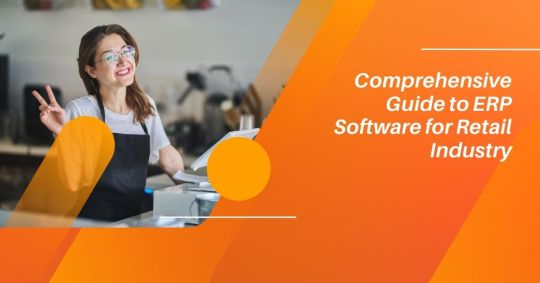
Retail ERP vs. Traditional ERP
A erp software for retail industry system is catered to the special processes of multi-channel or omnichannel retailers. On the other hand, a traditional best erp software for retail is outfitted for general business requirements in different industries, e.g. manufacturing or construction. In retail ERP software, the center modules developed are around the workflow of the retail industry.
Some erp software for retail, for example, Brightpearl, can be designed such that they are retail ERPs. When you are looking for a retail version of classic ERP, you are spoilt for choice. Examples of ERP and accounting systems are Acumatica, NetSuite, Microsoft Dynamics 365, SAP Business One, and QuickBooks POS, to name just a few, whose frontend can be integrated with QuickBooks Desktop accounting software.
It pays to buy Quickbooks products and services from a value-added reseller that possess the experience in POS and the level of retail expertise to ensure your QuickBooks retail solution is fine-tuned.
It is possible to fit into a retail and traditional ERPs with an add-on software that serves with purpose specifically for retailers. For Example, AP automation or global mass payments software, for retailers ; Tipalti .Software has enabled companies like Touch of Modern to effectively handle accounts payable and large payment workflows with a small team.
Retail ERP Benefits
The ten good things in a retail ERP are:
Real-time visibility reporting and payment processing
An integrated omnichannel system across the front and back ends
Centralized customer database
eCommerce and physical store integration with an automated POS
Demand forecasting capability
Intelligent procurement, replenishment, and supply chain management
Real-time inventory management
Dynamic pricing capability
Automation in processes for efficient cost savings
Data analytics to support data-driven decision making.
Retail ERP is a real-time, specially customized software system connecting and integrating business processes involved in retail operations. A retail ERP enables retailers to better streamline, automate, and manage front-end and back-office business processes. This is software specially customized for ERP that's designed to help retailers improve their bottom line.
Multichannel commerce involves driving sales through physical retail stores (brick-and-mortar), e-commerce, call centers, and other online sales channels. They may access one or more warehouses and rely on inventory management to fulfill the orders and manage returns.
Automate and Extend Your Retail ERP
Tipalti powers efficiency and enhanced functionality in accounts payable. For businesses, our touchless invoice processing solutions reduce your business expenses.
Best Retail ERP Software Solutions
The erp software for retail business are either specifically designed for the retail sector or part of the traditional ERP systems, add-on third-party integrations poised at elevating the ERP for retail operations.
ERP Systems That Can House Retail-Specific Needs
Some best available ERP systems for retailers include:
Brightpearl
Brightpearl – A review
Brightpearl is an omnichannel retail ERP software solution designed for retailers and wholesalers.
The company bills its software as a Digital Operations Platform that can process thousands of orders daily. Brightpearl is purpose-built retail ERP. It offers eCommerce integrations with BigCommerce, Magento, Shopify, Amazon, eBay, and even Walmart these are erp software for retail shop.
Stated differently, Brightpearl, the retail version of Sage, allows for:
Real-time data
Sales order management
Inventory management and demand planning
Shipping and fulfillment
Warehouse management
Retail accounting
Purchasing and supplier management
Workflow automation
Reporting and business intelligence
Built-in, pre-integrated third-party app solutions for new channels and functional tools
SAP Business One
SAP Business One is ERP software that functions in the cloud for small and mid-sized businesses. By augmenting the following functionality to the ERP software, retailers using SAP Business One get support for:
eCommerce and omnichannel
Back office, online, and in-store operations
Point of sale and payment processing
In-store and inventory management
Analytics and reporting
Acumatica Retail-Commerce Edition
Acumatica
This is Acumatica's retail and eCommerce ERP solution. It is a multi-channel, cloud-based software, and it is best branded as the 'Retail-Commerce Edition' by small and middle-market businesses. Acumatica offers 24/7 customer service as a core feature in ERP.
It has other features such as:
Financial management
CRM
Warehouse management
Sales Order Management
Customer Self-Service Portal
Reporting and data analysis tools
Inventory management
Purchase
0 notes
Text
How Much Does It Cost to Build an eCommerce Website?
Introduction
Building an eCommerce website can be an exciting venture, but one of the first questions that comes to mind is, “How much will it cost?” Understanding the various factors that influence the cost can help you budget effectively and make informed decisions. Let’s break down the costs associated with building an eCommerce website.
Types of eCommerce Websites
Small Business eCommerce Websites
Small business eCommerce websites typically have fewer products and simpler features. They are perfect for startups or small enterprises looking to establish an online presence without breaking the bank.
Medium-sized Business eCommerce Websites
These websites cater to businesses that have a larger product range and need more advanced features like customer accounts, detailed product descriptions, and sophisticated marketing tools.
Large Enterprise eCommerce Websites
Large enterprise eCommerce websites are designed for big businesses with a vast product catalog and high traffic. These sites require advanced functionalities, robust security, and high scalability.
Factors Influencing eCommerce Website Costs
Platform Choice
Choosing the right platform is crucial. Options range from open-source platforms like WooCommerce and Magento to SaaS platforms like Shopify and BigCommerce, and custom-built solutions. Each has its own cost implications.
Design and Customization
The design and level of customization can significantly affect the cost. Templates are cheaper, while custom designs tailored to your brand are more expensive.
Development Team
The choice between hiring in-house developers, freelancers, or an agency will impact the cost. Agencies tend to be pricier but offer comprehensive services.
Features and Functionalities
The more features and functionalities you require, the higher the cost. Basic features include product management and checkout systems, while advanced features like AI-powered recommendations and custom integrations cost more.
Hosting and Maintenance
Ongoing costs include hosting, security, and regular updates. These are essential to keep your website running smoothly and securely.
Platform Choices and Costs
Open Source Platforms
Platforms like WooCommerce and Magento are free to use, but you’ll need to pay for hosting, themes, and plugins. Development and maintenance costs can add up.
SaaS Platforms
Shopify and BigCommerce offer subscription-based pricing that includes hosting, security, and support. These are easier to manage but can be more expensive over time.
Custom-Built Solutions
Custom-built solutions offer the most flexibility but are the most expensive. They require a team of developers and ongoing support.
Design and Customization Costs
Templates vs. Custom Designs
Using a pre-designed template is cost-effective, while custom designs offer a unique look but at a higher price.
UI/UX Considerations
Investing in good UI/UX design improves user experience and can increase sales but adds to the cost.
Branding and Aesthetics
Tailoring the design to match your brand’s aesthetics requires additional work and resources.
Development Team Costs
In-house vs. Freelancers vs. Agencies
In-house teams provide control and consistency but at a higher cost. Freelancers are more affordable but might lack continuity. Agencies offer comprehensive services but are the priciest option.
Hourly Rates and Project-based Pricing
Rates vary widely depending on the expertise and location of the developers. Project-based pricing can provide more predictable costs.
Essential Features and Their Costs
Product Catalog Management
Managing a product catalog involves organizing products, adding descriptions, and setting up categories. This is a fundamental feature for any eCommerce site.
Shopping Cart and Checkout
A seamless shopping cart and checkout process are critical. Integrating payment gateways adds to the cost but is necessary for handling transactions.
Payment Gateway Integration
Popular payment gateways like PayPal, Stripe, and others charge fees for transactions and integration.
User Accounts and Profiles
Allowing users to create accounts and profiles enhances the shopping experience but requires additional development.
Mobile Responsiveness
Ensuring your website works well on mobile devices is essential, as more consumers shop via smartphones.
Advanced Features and Their Costs
Advanced Search and Filtering
Advanced search options and filters improve user experience but require additional coding.
AI-Powered Recommendations
Implementing AI for product recommendations can boost sales but is a significant investment.
Multi-language and Multi-currency Support
If you’re targeting a global audience, supporting multiple languages and currencies is crucial.
Subscription Models
Offering subscription services requires a different set of functionalities and integration.
Custom Integrations
Integrating with ERP and CRM systems streamlines operations but adds to the cost.
Hosting and Maintenance Costs
Shared vs. Dedicated Hosting
Shared hosting is cheaper but less secure and slower. Dedicated hosting is more expensive but offers better performance and security.
SSL Certificates and Security
SSL certificates are a must for securing transactions. Additional security measures protect against cyber threats.
Regular Updates and Support
Ongoing updates and support are necessary to keep your website running smoothly and securely.
Marketing and SEO Costs
On-site SEO
Optimizing your site for search engines is crucial for driving organic traffic.
Content Marketing
Creating valuable content attracts and engages customers but requires time and resources.
Social Media Integration
Integrating social media allows you to reach a broader audience but involves additional setup and maintenance.
Email Marketing
Setting up and maintaining email marketing campaigns helps retain customers and drive sales.
Additional Costs to Consider
Legal and Compliance Fees
Ensuring your site complies with legal requirements and industry standards can incur additional costs.
Third-Party Apps and Plugins
Using third-party apps and plugins enhances functionality but adds to the overall cost.
Analytics and Reporting Tools
Investing in analytics tools helps track performance and make data-driven decisions.
Case Studies
Example 1: Small Business eCommerce Website
A small business website with basic features and a template design can cost between $2,000 and $10,000.
Example 2: Medium-sized Business eCommerce Website
A medium-sized site with more advanced features and custom design can range from $10,000 to $50,000.
Example 3: Large Enterprise eCommerce Website
A large enterprise website with extensive features and custom-built solutions can cost upwards of $50,000.
Budgeting for Your eCommerce Website
Initial Setup Costs
Consider the initial setup costs, including design, development, and platform fees.
Ongoing Operational Costs
Don’t forget to budget for ongoing costs like hosting, maintenance, and marketing.
Conclusion
Building an eCommerce website involves various costs depending on your needs and choices. By understanding these factors, you can make informed decisions and budget effectively. Whether you’re a small business or a large enterprise, investing in a robust eCommerce site can pay off in the long run.
FAQs
How can I reduce the cost of building an eCommerce website?
Opt for a template design, use open-source platforms, and start with essential features only.
Is it cheaper to use a template or hire a designer?
Using a template is cheaper, but a custom design offers a unique brand identity.
How much should I budget for ongoing maintenance?
Ongoing maintenance can cost between $500 to $2,000 per month, depending on the complexity of the site.
Can I build an eCommerce website on my own?
Yes, using platforms like Shopify or WooCommerce, but it may require some technical skills.
What are the hidden costs of running an eCommerce website?
Hidden costs include payment gateway fees, app/plugin subscriptions, and marketing expenses.
0 notes
Text
🚀 Shopify vs BigCommerce vs Magento vs WooCommerce 🚀
Are you ready to take your online store to the next level in 2024?
🌟 Our latest blog post dives deep into a comprehensive comparison of the top eCommerce platforms. Discover which one is best for your business! 📈✨
🔗 https://techfee.com/shopify-vs-bigcommerce-vs-magento-vs-woocommerce/
#eCommerce#OnlineStore#Shopify#BigCommerce#Magento#WooCommerce#DigitalMarketing#TechFee#seo#graphicsdesigning
0 notes
Text
Top 10 Features of BigCommerce
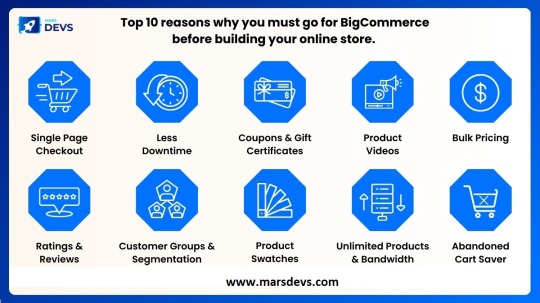
BigCommerce is an affordable e-commerce solution that is easy to set up and ramp up. Its user interface is highly intuitive and users can set up a simple shop page. It supports different pre-built plug-ins. This MarsDevs infographic will discuss the in-depth details top 10 features of BigCommerce.
Click here to know more: https://www.marsdevs.com/blogs/shopify-vs-magento-vs-bigcommerce-2024-comparison
0 notes
Text
Why Choose Celigo Integrator.Io Over Building Custom API Integration?
In the world of data integration, the debate between using a platform like Celigo integrator.io vs building a custom API integration is a hot topic. This article aims to shed light on why Celigo might be a better choice for your business.
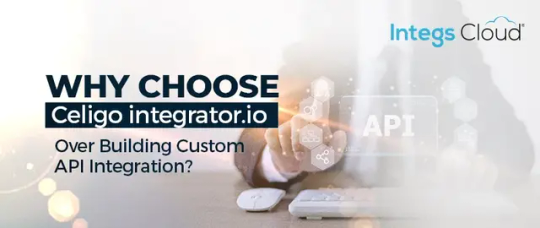
What Is Celigo Integrator.Io?
Celigo integrator.io is a leading iPaaS (Integration Platform as a Service) platform that allows businesses to connect their applications and automate business processes. With its robust iPaaS platform, businesses can seamlessly connect their systems such as Oracle NetSuite, Salesforce, Amazon, Shopify, BigCommerce, 3PL Systems and similar other applications.
Celigo Integrator.Io Vs Custom API Integration
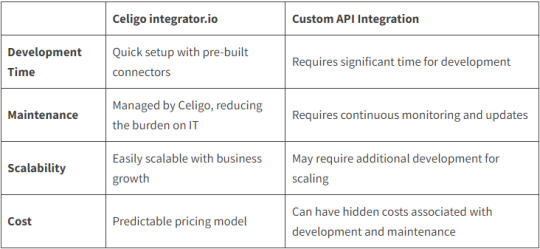
Key Advantages Of Celigo Integrator.Io
Pre-built Connectors: Celigo offers pre-built connectors for integration use cases like Oracle NetSuite ERP integration with Shopify, Amazon, BigCommerce, Salesforce, Magento 2, etc., which significantly reduces the time and effort required to set up integrations.
Scalability: As your business grows, so does your data. Celigo, integrator.io ensuring your integrations can handle increased data volume.
Reduced IT Burden: With Celigo integrator.io, the burden on IT teams is significantly reduced as the platform manages the integrations, freeing up resources for other tasks.
Cost-Effective: Unlike Custom API Integrations, which can have hidden costs associated with development and maintenance, Celigo offers a predictable pricing model.
In conclusion, Custom API integration development offers flexibility, however on the other side, the quick setup, scalability, reduced IT burden, and cost-effectiveness of Celigo make it a compelling choice for businesses looking to streamline their processes with efficient integrations. The Celigo integrator.io is a testament to the platform’s capabilities and effectiveness.
Integs Cloud: Your Trusted Celigo Integration Partner
Integs Cloud is a certified Celigo partner that provides end-to-end integration services, from consulting and implementation to support and maintenance. With a team of experienced and certified Celigo experts, Integs Cloud can handle any integration challenge and deliver solutions that meet your business needs and goals.Whether you need to integrate Oracle NetSuite with Shopify, Amazon, BigCommerce, Salesforce, Magento 2 or any other applications, Integs Cloud can help you achieve it with the Celigo iPaaS platform. Contact Integs Cloud today and get a free consultation and quote for your integration project.
#IntegsCloud#DataIntegration#DataAutomation#Celigo#CeligoVsCustomAPI#IntegrationSolutions#APIIntegration#DataFlow#iPaaS#Integration#Automation#API#SaaS#Enterprise#Tech#Technology#ERP#Software
0 notes
Text
Magento Vs Shopify Vs BigCommerce Vs WooCommerce – Which eCommerce Platform Is Best For You?
Selecting the appropriate eCommerce platform is essential for companies looking to go online. The market has a number of strong options, each with special advantages. Among the well-liked options, Magento, Shopify, BigCommerce, and WooCommerce are notable for meeting various business requirements.
0 notes
Text
SHOPIFY VS WOOCOMMERCE VS MAGENTO VS BIGCOMMERCE
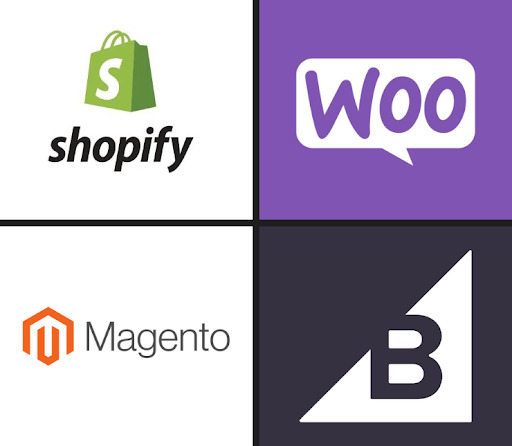
Embarking on the online selling journey can be daunting, but with the right e-commerce platform, you can pave the way for success. This comprehensive guide explores four popular platforms – Shopify, WooCommerce, Magento, and BigCommerce – delving into their strengths, ease of use, customization options, pricing, and customer support. By the end, you'll be equipped with the knowledge to make an informed decision for your online business.
1. Shopify: Ideal for Beginners with Its User-Friendly Interface and Hosted Service Approach.
2. WooCommerce: Leverages the Power of WordPress, Offering Extensive Customization Options and Scalability.
3. Magento: Known for Its Super Customizability and Flexibility, Catering to Large-scale Online Stores.
4. BigCommerce: A Comprehensive Solution with All-in-One Features and a Beginner-Friendly Interface.
Exploring each platform's setup process, design flexibility, cost structure, and customer support, you'll gain insights into which platform aligns best with your business goals and technical expertise.
For the full guide and detailed comparisons, visit https://srutatech.com/2024/02/29/shopify-vs-woocommerce-vs-magento-vs-bigcommerce-2/
#app development#digitalmarketing#software development#web development#digital marketing bensalem#digitalmarketingseo#digitalmarketingbensalem#digital marketing#digital marketing philadelphia#seo
0 notes
Text
Shopify vs. Other Ecommerce Platforms: Which One Is Right for You?
Choosing the right ecommerce platform depends on your specific business needs, budget, technical expertise, and future growth plans. Shopify is a popular choice, but there are other alternatives that might suit your requirements better. Here's a comparison between Shopify and some other ecommerce platforms:
Shopify:
Pros:
User-friendly interface.
Hosted solution, so no need for separate hosting.
Extensive app store for added functionality.
Good customer support.
Suitable for beginners and small to medium-sized businesses.
Cons:
Monthly subscription fees.
Transaction fees for using external payment gateways (unless you use Shopify Payments).
Customization options may be limited for advanced users.
WooCommerce (WordPress):
Pros:
Built as a WordPress plugin, offering flexibility.
Open-source and customizable.
Large community and numerous plugins available.
No transaction fees (but you may incur fees from your chosen payment gateway).
Cons:
Requires a separate hosting solution.
Some technical knowledge required.
May need additional plugins for advanced features.
Magento:
Pros:
Highly customizable and scalable for large enterprises.
Open-source community edition available.
Robust feature set for complex ecommerce needs.
Excellent for large catalogs and high traffic.
Cons:
Higher development and maintenance costs.
Steeper learning curve, not as beginner-friendly.
Resource-intensive and may require dedicated hosting.
BigCommerce:
Pros:
Hosted solution with a wide range of features.
Good scalability for growing businesses.
No transaction fees.
Solid support and security features.
Cons:
Monthly subscription fees can be higher.
Customization options might be limited for advanced users.
Wix eCommerce:
Pros:
User-friendly drag-and-drop website builder.
All-in-one solution with hosting included.
App market for additional functionalities.
Cons:
May not be as suitable for large or rapidly growing businesses.
Less flexibility compared to some other platforms.
Squarespace:
Pros:
Elegant design templates.
All-in-one solution with hosting.
Easy to use for beginners.
Cons:
Limited scalability for large businesses.
Transaction fees unless using Squarespace Payments.
Ultimately, the best platform for you depends on your specific needs. If you prioritize ease of use and quick setup, Shopify might be a good fit. For more control and customization, platforms like WooCommerce or Magento could be better. Evaluate factors such as budget, technical expertise, scalability, and the specific features your business requires before making a decision. To know more visit us at https://magnigeeks.com/
0 notes
Text
#Best Web Design and Development company in India#Web development company in Chennai#Web designing company Chennai#web application development company in Chennai#UI UX design company in Chennai#ecommerce website development company in chennai#e commerce website development in chennai
0 notes
Text
Compare Shopify with other e-commerce platforms like WooCommerce, Magento, and BigCommerce. Discover why Shopify's user-friendliness and extensive app store make it a top choice. Explore Webgarh Solutions for expert Shopify development services.
#webgarhsolutions#hire shopify developer#shopify development company#shopify development services#shopify
0 notes
Text
Top 5 Factors To Consider While Choosing The Right eCommerce Platform
More than just setting up an online store is required when launching an eCommerce website. An eCommerce website allows you to convert your real store to a virtual one. You may construct an online store to sell your products and services with the help of an eCommerce website.
Ecommerce is the quickest way of getting customers the products or services they want. Having an internet-store does not imply that the physical store will close. It indicates you’re offering a new way for your firm to expand its reach and revenue.
If you want to take your business to the next level by allowing your customers to shop your products and services from the comfort of their own homes, you should consider and evaluate your alternatives for developing an eCommerce website.
So, here’re the top 5 most important factors for choosing the right eCommerce platform.
What is an eCommerce Platform?
An eCommerce platform is a software application that facilitates the purchasing and selling of items over the internet by performing fundamental business tasks. Many operational and customer-facing operations are harmonized by modern eCommerce platforms. They offer analytics and reporting, as well as customer service, order and inventory management, and financial accounting.
On top of drool-worthy SEO, the most popular eCommerce platforms like Magento, Shopify, and BigCommerce offer a plethora of customization choices. When picking a website builder, load time, mobile-friendliness, multi-channel integration, and marketing features are all crucial factors to consider.
Top 5 Factors To Consider While Choosing The Right eCommerce Platform
Costing and Payment
The pricing is, without a question, the most important factor to consider while looking for the best e-commerce platform. You need to know exactly what you’re going to pay, regardless of the kind and size of your organisation or whether you’re a startup or a well-established firm.
Every site will almost certainly demand a monthly charge. Prices may differ depending on the type of platform you choose (self-hosted vs. hosted). You must remember to account for the platform’s processing fees. To find the finest deal within your budget, try to weigh the benefits and drawbacks of each factor
Integrations
Another important feature of the ideal platform is its seamless integration and appropriate plugins. Most platforms, such as WooCommerce and Shopify, include a wealth of tools and functionality to help you operate your business smoothly. Of course, the type and needs of your business will determine which plugins you should have and which ones will function best for you. Check out the types of tools you’ll need or are already using for your business when looking at the various platforms.
Security
The most critical element is security, as no one wants to enter their financial or credit card information on an unsafe website. As a result, security is a critical issue that you must not overlook, as it is one of the top worries among consumers. Despite the fact that most software today has strong security, make sure your platform supports HTTPS/SSL for a safe and secure checkout experience for your clients. Make certain that the e-commerce platform you chose is PCI (Payment Card Industry) compliant as well.
Read more about : factors to consider while choosing the ecommerce platform
if you want to build your ecommerce store contact the best ecommerce development company in India - Weingenious.com
#software#ai generated#mobile#technology#website#ecommerce web design services#ecommerce#ecommerce website developer compny#ecommerce web development company#ecommerce business#ecommerce seo#ecommerce website design#ecommerce development company#ecommerce website development#software development#software company#software developers#web developing company#web developers#web development#websites#online store#it company
0 notes
Text
#Monteage#bestecommerceplatform#eCommerce#ecommercewebsite#ecommercebusiness#wordpressecommerce#onlinesales#ecommercewebsitedesign#ecommercesolutions#onlinebusiness
0 notes
Text
Shopify vs BigCommerce vs Magento vs WooCommerce: Which is Best for Your Online Store in 2024
Choosing the right e-commerce platform is crucial for your business’s success. In this comparison of Shopify vs BigCommerce vs Magento vs WooCommerce, we’ll explore their features, ease of use, pricing, and more to help you find the best fit for your online store in 2024. In the fast-paced world of e-commerce, where every click can lead to a sale, picking the right platform for your online store…
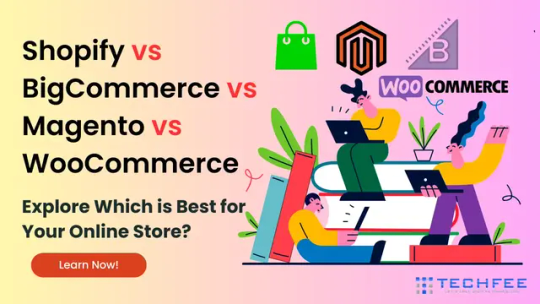
View On WordPress
0 notes
Text
Shopify Vs Magento Vs BigCommerce (2024 Comparison)
youtube
SaaS e-commerce platforms are cloud-based software that facilitates building e-stores. They offer options for different budgets, business needs, and IT landscapes. SaaS e-commerce platforms work on a subscription model & are easier to maintain and are kept updated. They offer several security features and are quick to install. Let us delve into some of the key features of Shopify, Magento, and BigCommerce. This MarsDevs article will discuss the in-depth details of Shopify, Magento & BigCommerce websites.
0 notes